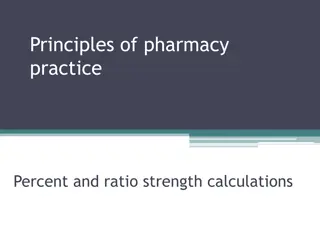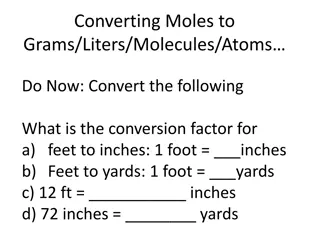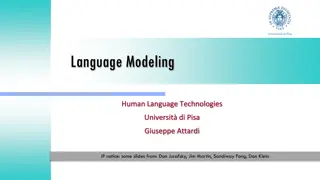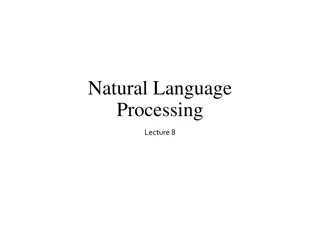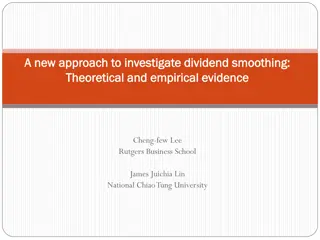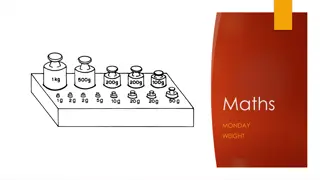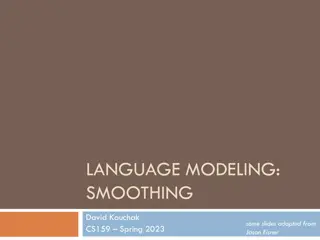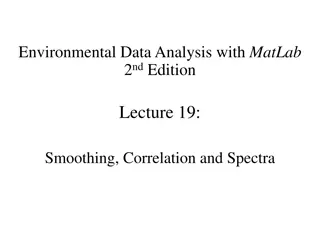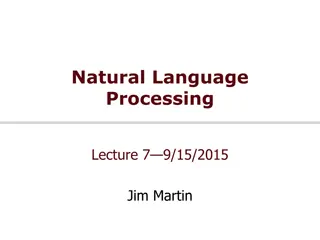
N-Grams and Smoothing: Understanding Language Patterns
Explore the concept of N-Grams and smoothing, which involves analyzing short sequences of words to predict future events in text data. Discover its applications in OCR, voice recognition, spelling correction, machine translation, and more. Learn about the Shannon Game and statistical estimators for developing predictive models based on training data.
Download Presentation

Please find below an Image/Link to download the presentation.
The content on the website is provided AS IS for your information and personal use only. It may not be sold, licensed, or shared on other websites without obtaining consent from the author. If you encounter any issues during the download, it is possible that the publisher has removed the file from their server.
You are allowed to download the files provided on this website for personal or commercial use, subject to the condition that they are used lawfully. All files are the property of their respective owners.
The content on the website is provided AS IS for your information and personal use only. It may not be sold, licensed, or shared on other websites without obtaining consent from the author.
E N D
Presentation Transcript
N-Grams and Smoothing Manish Shrivastava
Basic Idea: Examine short sequences of words How likely is each sequence? Markov Assumption word is affected only by its prior local context (last few words)
Possible Applications: OCR / Voice recognition resolve ambiguity Spelling correction Machine translation Confirming the author of a newly discovered work Shannon game
Shannon Game Claude E. Shannon. Prediction and Entropy of Printed English , Bell System Technical Journal 30:50-64. 1951. Predict the next word, given (n-1) previous words Determine probability of different sequences by examining training corpus
Forming Equivalence Classes (Bins) n-gram = sequence of n words bigram trigram four-gram or quadrigram
Reliability vs. Discrimination large green ___________ tree? mountain? frog? car? swallowed the large green ________ pill? candy?
Reliability vs. Discrimination larger n: more information about the context of the specific instance (greater discrimination) smaller n: more instances in training data, better statistical estimates (more reliability)
Selecting an n Vocabulary (V) = 20,000 words n Number of bins 2 (bigrams) 400,000,000 3 (trigrams) 8,000,000,000,000 4 (4-grams) 1.6 x 1017
Statistical Estimators Given the observed training data How do you develop a model (probability distribution) to predict future events?
Maximum Likelihood Estimation ?(?1 ??) ?(?1 ?? 1) ???????1 ?? 1 = Estimate sequence probabilities using counts or frequencies of sequences Problems Sparseness What do you do when unknown words are seen??
Smoothing Higher order n-grams perform well but suffer from data sparsity Lower order n-grams are not reliable Standard MLE does not work for unseen data
Smoothing Laplace smoothing (add-one) Lidstone s law Jeffereys-Perks law Held-out Estimation Cross Validation (Deleted Estimation) Good Turing Estimation Back-Off Linear Interpolation Katz Backoff General linear Interpolation
Laplace Smoothing The oldest smoothing method available The oldest smoothing method available Each unseen n Each unseen n- -gram is given a very low estimate gram is given a very low estimate ????(?? ?? ???) =? ?? ??+? ?+? Probability 1/(N+B) or Frequency (estimated) N/(N+B) N is the number of seen n-grams and B is the number of possible n-grams
Zipfs Law Small number of words with very large frequency Some words with moderate frequency Very large number of words with very low frequency
Lidstones Law The probability mass assigned to unseen events is too high with Laplace smoothing Solution : assign smaller addition ?????? ?? ??? =? ?? ??+? ?+?? Jeffereys-Perks law Set ? as Expectation of ? that maximizes above equation
Held Out Estimation Why do we think that the mass assigned to unseen words is too high? Can we somehow test it empirically? Yes Train (get counts) from one large text and check against another Held Out data ?? ??? ????? ?? = Where, Tr is the sum of number of times n-gram with frequency r appeared in held-out data, and Nr is the number of n-grams with frequency r in training data. In effect, assigning the average probability of ????? ?? to the n-gram with frequency r
Held-out Estimation Probability is calculated keeping both training and held-out data in mind. Is it the best estimate? In this scenario? If the role of training and held-out data is reversed ? ???? ?? ????? ?? = ?? ???? ?? ????? ?? = ??
Deleted Estimation (Cross-Estimation) Jelinek and Mercer 1985 ????+???? (?? ?????? ?? = ?+?? ?)? Performs really well Still a way off for low frequency events
Good-Turing Smoothing Use Number of times n-grams of frequency r have occurred To fit for both high frequency and low frequency terms, use a curve fitting function ????? ?? =? ? Where ? =(?+?)?(?+?) ?(?) For unseen events, ?? ? ?? ????? ?? = Simple Good Turing S() = Power Curve for high frequency terms ??= ???
Back off So far, all we have done is get estimates for various n-grams Problems (Same old), For n-grams with low frequency, estimates are not really good Solution, If n-gram does not work, fall back to (n-1)-gram Better still, combine estimators for n-gram, (n-1)-gram, (n-2)-gram unigram
Linear Interpolation ??????1 ?? 1 = ?1? ?? + ?2??????? 1 + ?3??????? 1,?? 2 Works really well Reserve Probability mass for unseen items ??s need to be learned separately
Katz Back-off ?(?1 ??) ?(?1 ?? 1)if Counts are greater than a certain k ??????1 ?? 1 = ? Else ??????1 ?? 1 = (1 ?) ??????2 ?? 1
General Linear Interpolation Why just back off to immediate lower order? This method allows random back off schemes moderated by the weights This method allows random back off schemes moderated by the weights ??s s One might back off to any of the lower orders or to any other estimator as chosen by One might back off to any of the lower orders or to any other estimator as chosen by the designer the designer ? ????? = ?=1 ??????



